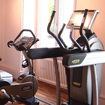Listening and Speaking Practices about Cyberchondria
Upper Intermediate level
Description
Materials
Main Aims
-
To provide students practice in listening for gist and detail through a radio interview with a doctor talking about websites.
Subsidiary Aims
-
To enable students for speaking practice in the context of health.
Procedure (45-55 minutes)
Give them the picture I draw that is relevant to previous lesson about cyberchondriac. Ask them quickly whats happening in this picture ; What emotion you see on his face? Answer: Worried. What do you think he is doing? Answer: Searching online about an illness/symptoms/causes/disease/red skin/rash...? etc. Elicit the story from Ss.
Hand out the prelistening visual activity. Let them match the corresponding words in the activity, then class check. Predict unfamiliar words from the listening script on pp33 of Ts Bk and quickly pre-teach some of the vocabulary. Elicit their meaning from students.
To use top down processing as lead in activity a picture is given to SS to make connection with what they will be listening at this stage. They are also given the relevant vocabulary at pre-listening stage. Type on the board: The Doctor and The Interviewer Subject: This radio interview about a doctor's point of view for cyberchondriacs Explain them the adapted listening activity instructions for part a) then hand out the task to SS. Check their understanding of the task. Have them listen to CD1 41. Let them discuss with their partner. Feedback. (Nominate SS ask for the answer)
Explain them the adapted listening activity instructions for part b). Check their understanding of the task. Have them listen to CD1 41 again. Student work alone for answers. Then peer check. Feedback. (Nominate SS ask for the answer)
Hand out the activity exe c SS. Have them work in pairs. Ask/Answer to each other. Then nominate some SS for their answers to the whole class.
Give instructions : Ss take parts of doctor/patient for the activity. Student A will be the doctor and student B will be the patient. B will start the game and A will be asking questions to B. Then A will be the patient and B will be the doctor. Same procedure will apply. Hand out the role play activity. Make pairs or groups:If there is odd number of students give 2 Ss A,1 S B. Tell them to sit face to face. Tell Ss to use present perfect tense:'How long have you been feeling like this?' when talking about the symptoms. Monitor Ss during the activity. Walk around and listen to their communication, take notes of the errors for delayed error correction after this activity.

